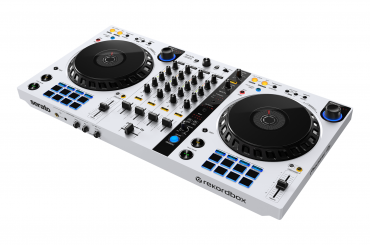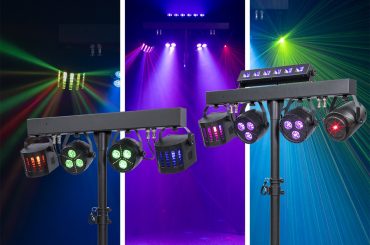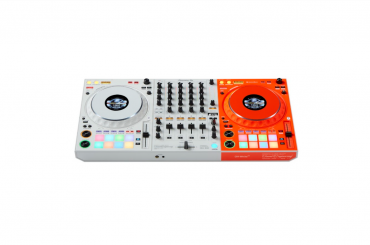By Mike Gwertzman
Casual observers of Swedish EDM superstars Dada Life can quickly glean that the duo of Ollie “Olof” Cornéer and Stefan Engblom are the polar opposites of the dour, black-clad, too-cool-for-school “serious artists” that make up the majority of the electronic-music landscape.
These guys are all about good times, being goofy, having fun, and encouraging their legions of fans to do the same. And if you’ve ever witnessed a Dada Life show, replete with their communal pillow fights, champagne showers, and hordes of pogoing partiers in banana costumes, it’s clear that their message has resonated far and wide.
It’s no surprise, then, that anything with Dada Life’s name on it will represent this same kind of silly joie de vivre, and that’s the first thing you notice when you fire up Endless Smile, the brand-new plug-in created by Dada Life. The most prominent visual element of Endless Smile is a cartoon character, an orange-haired, pale-green fellow with an oversized head, wearing pink shorts and sneakers. He’s not looking too happy, in fact, his drooping face and dour expression makes him look downright miserable.
What to do? Well, let’s try that “Intensity knob” just to the left, and as you turn the dial to the right, lo-and-behold, Mr. Grumpy raises his arms, a huge smile emerges, and suddenly you’re feeling pretty happy about the joy you’ve given to this animated individual.
Created in collaboration with Swedish software developer Tailored Noise, Endless Smile follows up on their first plug-in, the very successful – and widely used – Sausage Fattener. That plug-in was designed to fatten up sounds (basslines, synth leads, kicks) to mimic Dada Life’s production sound. Endless Smile is essentially a buildup enhancer. It’s designed to add tension and color to the peak-moment buildups that are standard issue for most festival-worthy EDM and progressive house tracks, which is, not coincidentally, the music that Dada Life is known for.
Endless Smile is very simple to use. It has only one knob (the above-mentioned Intensity dial), and a series of creatively titled presets that range from “soft” to “extreme.” For example, “Fist in the Air” and “Helium Jumping” both classify as soft, while “Broken Teeth” is designated “hard.” As you adjust the dial, you get a percentage readout of just how intense things are getting (from 0 to 110-percent). The cartoon character doesn’t have any functionality other than adding a bit of a fun –and a goofy visual representation of what’s going on.
So what is Endless Smile actually doing? That’s a bit of a secret. Dada Life hasn’t revealed what is going on under the hood, but it’s clear that reverbs, filters, delays, saturators, LFOs, noise modulators and barber poles are all being utilized here. There’s no way to add any fine-tuning or adjustments to the effects being used, which is perhaps the biggest drawback of the plug-in. Without a way to customize the different effects, you run the risk that your music sounds like anyone else’s who uses Endless Smile to color their buildups. But if you like buildups in your music, or even a bit of tension, then you’ll probably consider Endless Smile a must-buy. It’s a huge time-saver that quickly fuses together vast array of effects to do exactly what you want them to do – add some spice and flair to your buildups.
To hear what Endless Smile does, I opened up a few different projects and began adding the plug-in to some channel strips. What I found is that it works best for what it’s designed to do, and you’ll be able to hear clearly Endless Smile if you apply it to tracks with buildups, snare or drum rolls, or really any kind of repetitive percussive element.
I got the best results by sending my drums to a drum bus, and then adding Endless Smile on top of it. I set up an eight-bar loop and started cycling through the presets, and adjusting the Intensity knob. Endless Smile delivers the best results when the knob is in motion, which you can automate, or record live via a MIDI controller. The softer settings produce sounds similar to what you would hear with some of the DJ effects on the Pioneer DJM-900NXS mixer, especially the reverb and space effects.
For a more encompassing effect, you can place Endless Smile on the master output. There’s a nice cohesiveness here when everything gets run through it.
As you move down the presets and up the intensity, more and more sounds start emerging. Delays on the drums become evident, white noise rises up and drum rolls become more present in the mix. On the harder presets, rising “barber poles” or Shepard tones – the audio illusion of a perpetually rising tone – become very pronounced, and the filters become more extreme. Turning the intensity all the way to 110-percent on these settings filters out all of the audio, so you can go all the way from no effect to no audio.
Does Endless Smile have appeal to those who are not interested in over-the-top EDM bangers? Yes. For techno or deep house, I found that placing the plug-in (set to a “medium” preset with the intensity knob halfway up) on chord stabs added some nice color and depth to the sound, a smooth combination of reverb and delay that when automated, added a lot of movement to my tracks. But once you dip into the more extreme settings, the effects do naturally gravitate towards a big-room sound.
Dada Life deserves a lot of credit for developing a plug-in that has a lot of appeal. Endless Smile is amazingly simple to use with a virtually flat learning curve. But the results it gives you are top-quality. After a few hours of using it, I really started to appreciate its time-saving benefits. While Endless Smile doesn’t do all the work for you when arranging a buildup, it adds a lot of character very quickly, and makes automating multiple effects a breeze. While the bulk of its appeal is for those who do write and produce EDM- and festival-style tracks, there are benefits here for a wide array of producers. And at such a low price (the plug-in is only $39), it’s hard to say no. Ease of use and quick results are what Endless Smile brings to the table, and that’s a benefit that any producer would be hard pressed to pass on.
If you have any questions for Making Tracks, please send them to djtimes@testa.com.








